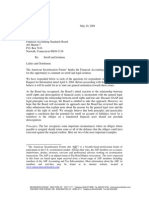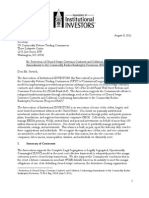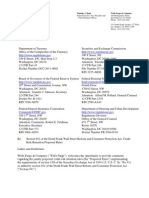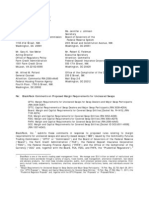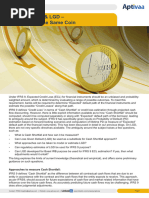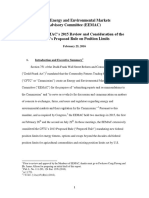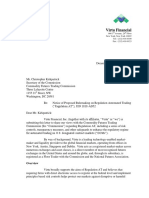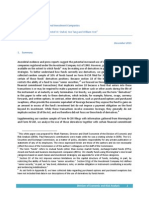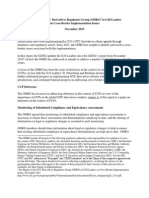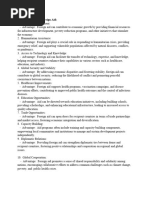An LSOC Tutorial: A New Customer Protection Model For Cleared Swaps Begins
An LSOC Tutorial: A New Customer Protection Model For Cleared Swaps Begins
Uploaded by
MarketsWikiCopyright:
Available Formats
An LSOC Tutorial: A New Customer Protection Model For Cleared Swaps Begins
An LSOC Tutorial: A New Customer Protection Model For Cleared Swaps Begins
Uploaded by
MarketsWikiOriginal Title
Copyright
Available Formats
Share this document
Did you find this document useful?
Is this content inappropriate?
Copyright:
Available Formats
An LSOC Tutorial: A New Customer Protection Model For Cleared Swaps Begins
An LSOC Tutorial: A New Customer Protection Model For Cleared Swaps Begins
Uploaded by
MarketsWikiCopyright:
Available Formats
An LSOC Tutorial: A New Customer Protection Model for Cleared Swaps Begins
By Joanne Morrison In November U.S. futures commission merchants and swaps clearinghouses will begin offering a new customer protection regime that differs from the traditional futures segregation model. This new customer protection model, called Legally Segregated Operationally Commingled, or LSOC, is a requirement established by Commodity Futures Trading Commission rules under the Dodd-Frank reforms. LSOC applies only to customer positions in cleared products that are in the U.S. swaps regulatory class, such as interest-rate swaps, credit-default swaps, and FX and commodity swaps and forwards. LSOC does not apply to futures.
he primary goal of LSOC is to protect cleared swaps customers from fellow customer riskthe risk that customers of an FCM could sustain losses if other customers of that same rm fail to satisfy payment obligations to the rm. LSOC is dierent from the traditional customer segregation model for futures accounts in many ways. e LSOC rules were approved by the CFTC in January, and compliance was mandated by Nov. 8. However, it has taken months of discussions among market participants, including central counterparties
(CCPs), sell-side rms, and buy-side rms, to determine how to implement LSOC requirements. Because of the tight deadline, the major swaps clearinghouses have each adopted a phased approach to implementing LSOC. e rst phase is set for a Nov. 5 launch in a manner that minimizes the operational and systems work. e second phase will then start in 2013. At an FIA workshop held in New York in September, representatives from CCPs and FCMs spent an afternoon discussing how the new LSOC rules will be implemented initially. CME, ICE and LCH.Clearnet rep-
resentatives explained their plans for implementing the new protections. is is a work in progress, said Arthur Magnus, managing director, and global head of futures and options and OTC clearing core operations at J.P. Morgan, who moderated the September workshop.
What is LSOC?
LSOC is designed to be an extension of the customer segregation model for U.S. futures. In the U.S. futures model, an FCM must hold customer funds physically separate from its house funds. is separate
34
Futures Industry | www.futuresindustry.com
pool of assets is called the segregated funds pool. At all times the rm must ensure that it maintains at least as much value in the segregated funds pool as is required to cover its liabilities to customers. Because the rm must often meet obligations of its customers to clearinghouses before it can collect from those customers, it must add a signicant cushion of its own assets into the segregated funds pool. e bank accounts or custody accounts that hold client assets, whether at the FCM or at a clearinghouse, are often referred to as client omnibus accounts, because they hold assets of many individual customers pooled together. Each day the FCM must perform a segregation calculation in which it veries that it is in compliance with the segregation requirements. e FCM must le a daily electronic report showing its segregation calculation with its designated self-regulatory organization, and under newly-adopted DSRO regulations, the DSRO must be provided with electronic access to the rms bank accounts to be able to verify that the funds are there. Under LSOC, as applied to customer positions in cleared swaps, the rm must perform a daily segregation calculation in exactly the same way as it does for futures. And client assets are still pooled together, exactly as with futures. However, the FCM must assure the clearinghouse that when it meets a margin call to a clearinghouse for customer positions, it never uses value provided by one customer to meet an obligation of another customer. is requires FCMs to perform a more precise calculation of each customers obligations to the clearinghouse. If one or more customers were to default to the FCM, and the FCM, in turn, defaulted to a clearinghouse in the customer origin, the clearinghouse can use value attributable to a particular customer only to cure losses of that customerand not for any other customer. To achieve these results, there are three key operational implications: 1) Clients must be identied to each clearinghouse at which they hold positions, 2) e clearinghouse must know the specic positions of each client, and 3) e collateral value for each client on deposit with the clearinghouse must be reported by the FCM to that clearinghouse at least daily. Because it is critical for the clearinghouse to know the collateral value of each client, the CFTCs LSOC regulations focus exten-
sively on the question of excess collateral i.e., collateral value provided by the client in excess of the minimum initial margin requirement for that client. e regulations provide each clearinghouse with a choice. In the rst alternative, the CCP may allow FCMs to pass a clients collateral value to the CCP in excess of the clients minimum margin requirement. If so, however, the CCP must provide the FCM with a means to provide a daily report of that value. is is called client-specic collateral value reporting.
FCM were to default to the CCP in the customer origin, the CCP could not use that unallocated excess value to cure losses of any customers, and would have to return it to a bankruptcy trustee when directed to for the benet of the clients. Because of the tight deadlines, all three major swaps CCPs have elected to implement LSOC rst in the no excess or unallocated excess model but will make the client-specic excess model available to FCMs and customers in 2013.
Client Identication, Onboarding and Position Reporting
All three CCPs indicated that they do not expect the processes for client identication, onboarding or position reporting to change signicantly, and that they are already in compliance with these aspects of the LSOC rules. e LSOC regime requires FCMs to identify each customer to the clearinghouse the rst time that the FCM clears a swap for that customer and then to provide information to the clearinghouse to identify the customers positions at least once each business day. Helen Fermor, credit business manager at ICE Clear Credit, explained that from an ICE perspective, when an FCM onboards new clients, it is required to identify the client legal entity. We call it a desk ID and we assign that to the client legal entity, she said. So there should be no change to the client onboarding process. e CFTCs LSOC rule requires the positions of each client to be disclosed to the clearinghouse at least once per day. is rule is embodied in the regulatory language that refers to the clients portfolio of rights and obligations. For swaps products at all three CCPs, the end client is identied at the time the trade is submitted for clearing, and hence there is real-time reporting of the portfolio of rights and obligations for each customer. e FCMs obligation under this rule is to reconcile its books and records at least once per day with the data les provided by the CCPs, which clearing rms already do.
In this rst phase, any amount of collateral that the FCM gives to CME in excess of the minimum margin requirement is deemed unallocated client excess. And in a default, the clearinghouse cant use any of that excess to cover any clients losses.
ED GOGOL, CME Group
Alternatively, the CCP could elect not to support client-specic collateral value reporting. is latter choice is referred to as the no excess model or the unallocated excess model. In this model, the protected value for each customer is dened as the clients initial margin requirement, and the CCP does not know the customer-specic attribution of any excess collateral value that the FCM provides to the CCP. If the
The Initial Implementation Phase of LSOC
LSOC will be implemented in a twophase approach. Initially, FCMs will be required to operate in the so-called no excess or unallocated excess mode, which is designed to
Futures Industry | November 2012
35
Risk Models: ICE
have minimal operational impact on FCMs beyond the daily LSOC compliance calculations. In this initial mode, there is no requirement for daily client-specic collateral value reporting from the FCM to the CCP. And if a clearinghouse is holding client excess collateral, the CCP cannot use it for any purpose. In the event of a default, this excess collateral would be returned to the bankruptcy trustee. In this rst phase, any amount of collateral that the FCM gives to CME in excess of the minimum margin requirement is deemed unallocated client excess. And in a default, the clearinghouse cant use any of that excess to cover any clients losses, said Ed Gogol, managing director, clearing architecture at CME Group. Fermor explained that in the rst phase, ICE will not use excess funds on deposits to cover an initial margin requirement. ICE will identify customer accounts with initial margin increases compared to the prior end-of-day settlement cycle and then issue a margin call to cover the sum of those customer initial margin increases. is will be called the LSOC top-up requirement. For LSOC compliance, we will be required to issue a margin call for the sum of client decits, Fermor said. Even if a customer within the FCM omnibus account has a decrease in its initial margin requirement and another customer has an increase, ICE can no longer oset them. is is to ensure that one customers excess cant be used to meet another customers requirement, Fermor said. Once an initial margin call has been met, an FCM has the option to request a withdrawal of any excess. FCMs will face more of an operational impact under LCH.Clearnet SwapClears rst phase of LSOC implementation. is initial phase is similar to ICE and CMEs plan, but there will be more frequent margin calculations because LCH.Clearnet issues intraday margin calls. Every time we accept a trade, we recalculate the required margin, said Nathan Ondyak, senior vice president and product manager at LCH. Clearnets SwapClear. This report breaks down the ownership interest in the collateral assets provided by the FCM to the CCP. This includes an amount for each customer and an amount provided by the FCM itself or the firm-contributed assets. The amount attributable to each customer is then considered as the legally segregated value for that customer. In the event of frame one that yet, said Ondyak. He also explained that once firms make this transition, it applies to all customer accounts. In other words, an FCM cannot be in a no excess mode for certain clients and in excess mode for others. ICEs Fermor also pointed to a February timeframe for beginning to support full client-specic excess. We havent made any decisions about when we will require all FCMs to adopt that mode and provide that reporting, said Fermor. CME will begin allowing FCMs to operate in the client-specic excess mode as early as Feb. 4. CMEs Gogol emphasized that it is very much in the FCMs interest to get to this second phase as soon as possible, as it will reduce the nancing impact of LSOC. CMEs deadline for rms to convert to the client-specic mode is May 27.
Still, clearinghouses and FCMs have geared up for this new customer protection system. And while the initial phase of implementation has been done in a comparatively simplied manner, rm representatives cautioned that rms will ultimately be required to provide the full level of LSOC reporting.
Challenges Remain
Diana Shapiro, North America head of OTC clearing product development at Citigroup Global Markets, explained that there still remain open issues on, among other things, how variation margin factors into the LSOC calculation and the treatment of foreign collateral. She cautioned that LSOC could present FCMs with liquidity issues. Also, Shapiro explained that once rms begin moving to the second phase of LSOC, which accommodates excess funds, they may need to perform their LSOC calculations multiple times a day. is is because under LSOC, rms cannot withdraw any excess collateral value of clients until the specic clients whose excess is being withdrawn have been identied. You cant just call us up and say I want to take out excess. We have to know who its for, agreed LCH.Clearnets Ondyak. Shapiro also highlighted the operational and compliance costs. ere is an IT build associated with this, and resource and personnel requirements, Shapiro said. Still, clearinghouses and FCMs have geared up for this new customer protection system. And while the initial phase of implementation has been done in a comparatively simplied manner, rm representatives cautioned that rms will ultimately be required to provide the full level of LSOC reporting. e CFTC has been very, very clear. ey are not moving this deadline. We need to comply, Shapiro said. ..............
Joanne Morrison is deputy editor of Futures Industry magazine.
LSOC Phase 2 Full ClientSpecic Value Reporting
In 2013 clearinghouses will amend their rules to permit customers to hold excess collateral at the clearinghouse. is means that the FCMs will be required to provide a collateral value report to each CCP at least once per day.
a default, the CCP may use that value only to cover the losses of that customer and for no other purpose. LCH.Clearnets Ondyak indicated that in February, SwapClear will move forward with its client-specific LSOC excess model, but on an optional basis. We will likely have a cut-off date where all members need to be on the with excess model but we have not put a time-
36
Futures Industry | www.futuresindustry.com
You might also like
- FAS 140 Setoff Isolation Letter 51004Document15 pagesFAS 140 Setoff Isolation Letter 51004Madu El Musa Bey92% (12)
- Chemistry Investigatory Project Class 12Document15 pagesChemistry Investigatory Project Class 12SOURAV SINGH75% (48)
- Hydrogen Peroxide Cancer TreatmentDocument10 pagesHydrogen Peroxide Cancer Treatmenttkocak999100% (1)
- FAS 140 Setoff Isolation Letter 51004 PDFDocument15 pagesFAS 140 Setoff Isolation Letter 51004 PDFMikhael Yah-Shah Dean: Veilour100% (1)
- Operator's Manual: Model 59A40001727Document28 pagesOperator's Manual: Model 59A40001727michel ChiassonNo ratings yet
- Difference Between Trust and Retention Account and Escrow AccountDocument12 pagesDifference Between Trust and Retention Account and Escrow Accountrao_gmail67% (6)
- Advanced Notice of Proposed Rulemaking Relating To Protection of Cleared Swaps Customers Before and After Commodity Broker BankruptciesDocument13 pagesAdvanced Notice of Proposed Rulemaking Relating To Protection of Cleared Swaps Customers Before and After Commodity Broker BankruptciesMarketsWikiNo ratings yet
- I. Summary of CommentsDocument5 pagesI. Summary of CommentsMarketsWikiNo ratings yet
- IsdaDocument13 pagesIsdaMarketsWikiNo ratings yet
- SB Qa FinalDocument2 pagesSB Qa FinalMarketsWikiNo ratings yet
- Segregation and Monitoring of Collateral at Client LevelDocument38 pagesSegregation and Monitoring of Collateral at Client Leveltempmail432165No ratings yet
- Pros and Cons of Different CLO ModelsDocument4 pagesPros and Cons of Different CLO ModelsJuan Carlos RussoNo ratings yet
- Discussion Paper: Risk Management - Safer Markets For InvestorsDocument10 pagesDiscussion Paper: Risk Management - Safer Markets For Investorsvaish2u6263No ratings yet
- Chatham Financial Counterparty Risk and Collateral ProtectDocument8 pagesChatham Financial Counterparty Risk and Collateral ProtectjitenparekhNo ratings yet
- SYLLABUS Abacus - Securities - Corp. - v. - Ampil20200226-4898-Rqy27fDocument4 pagesSYLLABUS Abacus - Securities - Corp. - v. - Ampil20200226-4898-Rqy27frmelizagaNo ratings yet
- MSP Ecp Qa FinalDocument6 pagesMSP Ecp Qa FinalMarketsWikiNo ratings yet
- Timothy J. Sloan Wells Fargo & CompanyDocument39 pagesTimothy J. Sloan Wells Fargo & CompanyMarketsWikiNo ratings yet
- Coll Seg CMDocument23 pagesColl Seg CMparminderjkbNo ratings yet
- SGCA Rules On Moneys Held in Customers' Segregated Accounts: Speed ReadDocument5 pagesSGCA Rules On Moneys Held in Customers' Segregated Accounts: Speed ReadBernard ChungNo ratings yet
- Chris YoungDocument11 pagesChris YoungMarketsWikiNo ratings yet
- Karrie McmillanDocument9 pagesKarrie McmillanMarketsWikiNo ratings yet
- Modelling Risk in Central Counterparty Clearing Houses:: A ReviewDocument13 pagesModelling Risk in Central Counterparty Clearing Houses:: A ReviewrinkidinkNo ratings yet
- LSOC Staff LetterDocument12 pagesLSOC Staff LetterMarketsWikiNo ratings yet
- Faqs Interop For Equitie June 13 April 16 1Document6 pagesFaqs Interop For Equitie June 13 April 16 1smolf2No ratings yet
- MSP Ecp Factsheet FinalDocument7 pagesMSP Ecp Factsheet FinalMarketsWikiNo ratings yet
- Notes On IFRS 9Document13 pagesNotes On IFRS 9Osman David KamaraNo ratings yet
- The Optimization of Everything: OTC Derivatives, Counterparty Credit Risk and FundingDocument8 pagesThe Optimization of Everything: OTC Derivatives, Counterparty Credit Risk and FundingsinghhavefunNo ratings yet
- Joanne MederoDocument9 pagesJoanne MederoMarketsWikiNo ratings yet
- Defs QaDocument3 pagesDefs QaMarketsWikiNo ratings yet
- Metlife 3Document5 pagesMetlife 3MarketsWikiNo ratings yet
- OTCDocument20 pagesOTCLameuneNo ratings yet
- Re: Blackrock Comments On Proposed Margin Requirements For Uncleared SwapsDocument5 pagesRe: Blackrock Comments On Proposed Margin Requirements For Uncleared SwapsMarketsWiki100% (1)
- Understanding The True Cost of Issuing Convertible Debt and Other Equity Linked FinancingDocument5 pagesUnderstanding The True Cost of Issuing Convertible Debt and Other Equity Linked Financing_lucky_No ratings yet
- A Capital Markets View of Mortgage Servicing RightsDocument31 pagesA Capital Markets View of Mortgage Servicing RightsekcnhoNo ratings yet
- Chicag o Fed Letter: Clearing and Settlement of Exchange Traded DerivativesDocument4 pagesChicag o Fed Letter: Clearing and Settlement of Exchange Traded Derivativesanand2807No ratings yet
- Literature Review On Credit Default SwapDocument5 pagesLiterature Review On Credit Default Swapea3d6w9v100% (1)
- Re: Clearing Agency Standards For Operation and Governance 17 CFR Part 240 (File No. S7-08-11 RIN 3235-AL13)Document4 pagesRe: Clearing Agency Standards For Operation and Governance 17 CFR Part 240 (File No. S7-08-11 RIN 3235-AL13)MarketsWikiNo ratings yet
- Cash Shortfall LGD - Two Sides of The Same Coin 1594098925 1Document8 pagesCash Shortfall LGD - Two Sides of The Same Coin 1594098925 1Dibya SahooNo ratings yet
- SB QaDocument2 pagesSB QaMarketsWikiNo ratings yet
- Scrap Metal LingoDocument4 pagesScrap Metal Lingoonzy12No ratings yet
- CMBS Basic Overview enDocument79 pagesCMBS Basic Overview enEd HuNo ratings yet
- SB Factsheet FinalDocument2 pagesSB Factsheet FinalMarketsWikiNo ratings yet
- Functions OF DepositoryDocument32 pagesFunctions OF DepositoryShakti ShivanandNo ratings yet
- Protected Cell Companies (PCCS) - The Present and FutureDocument4 pagesProtected Cell Companies (PCCS) - The Present and FutureAnupam ChomalNo ratings yet
- Schiff Hardin Derivatives & Futures Update (May 2012)Document12 pagesSchiff Hardin Derivatives & Futures Update (May 2012)mfearonNo ratings yet
- A Systematic Approach To Optimizing CollateralDocument7 pagesA Systematic Approach To Optimizing CollateralCognizantNo ratings yet
- CCD Tac CMRM Factsheet FinalDocument2 pagesCCD Tac CMRM Factsheet FinalDouglas AshburnNo ratings yet
- Developing and Implementing Commercial Loan Pricing ModelsDocument5 pagesDeveloping and Implementing Commercial Loan Pricing Modelsr.jeyashankar95500% (1)
- Know Before You Owe Mortgage Loan InitiativeDocument19 pagesKnow Before You Owe Mortgage Loan InitiativeLori NobleNo ratings yet
- Via Electronic Submission:: After Commodity Broker Bankruptcies (The "ANOPR")Document10 pagesVia Electronic Submission:: After Commodity Broker Bankruptcies (The "ANOPR")MarketsWikiNo ratings yet
- Settlement, Clearing & Risk ManagementDocument34 pagesSettlement, Clearing & Risk ManagementTapas Chandra RoyNo ratings yet
- Dcosidcofinres@Cftc - Gov: 75 Fed. Reg. 63113Document9 pagesDcosidcofinres@Cftc - Gov: 75 Fed. Reg. 63113MarketsWikiNo ratings yet
- CMO Monetization SummaryDocument7 pagesCMO Monetization Summarygalindo07No ratings yet
- 3qep3 Intraday CreditDocument16 pages3qep3 Intraday CreditFlaviub23No ratings yet
- Re: RIN 3038-AD99: Protection of Cleared Swaps Customers Before and After Commodity Broker Bankruptcies 75 Fed - Reg. 75162 (December 2, 2010)Document9 pagesRe: RIN 3038-AD99: Protection of Cleared Swaps Customers Before and After Commodity Broker Bankruptcies 75 Fed - Reg. 75162 (December 2, 2010)MarketsWikiNo ratings yet
- Dataline: A Look at Current Financial Reporting IssuesDocument5 pagesDataline: A Look at Current Financial Reporting IssuesdesferdetretreNo ratings yet
- Cleared Swap Handbook: Derivative Processing Under The Dodd-Frank Act and European Market Infrastructure Reform (Emir)Document16 pagesCleared Swap Handbook: Derivative Processing Under The Dodd-Frank Act and European Market Infrastructure Reform (Emir)senapatiabhijitNo ratings yet
- CMB S Borrower GuideDocument14 pagesCMB S Borrower Guideboobravi85No ratings yet
- The Challenges and Opportunities of Customer Profitability AnalysisDocument7 pagesThe Challenges and Opportunities of Customer Profitability AnalysisSarah ChengNo ratings yet
- CF Assignment - Group 2Document11 pagesCF Assignment - Group 2Poova RaghavanNo ratings yet
- Stuart KaswellDocument12 pagesStuart KaswellMarketsWikiNo ratings yet
- Minute Entry 336Document1 pageMinute Entry 336MarketsWikiNo ratings yet
- Federal Register / Vol. 81, No. 88 / Friday, May 6, 2016 / Rules and RegulationsDocument6 pagesFederal Register / Vol. 81, No. 88 / Friday, May 6, 2016 / Rules and RegulationsMarketsWikiNo ratings yet
- CFTC Final RuleDocument52 pagesCFTC Final RuleMarketsWikiNo ratings yet
- 34 77617 PDFDocument783 pages34 77617 PDFMarketsWikiNo ratings yet
- Eemac022516 EemacreportDocument14 pagesEemac022516 EemacreportMarketsWikiNo ratings yet
- Federal Register / Vol. 81, No. 55 / Tuesday, March 22, 2016 / NoticesDocument13 pagesFederal Register / Vol. 81, No. 55 / Tuesday, March 22, 2016 / NoticesMarketsWikiNo ratings yet
- Via Electronic Submission: Modern Markets Initiative 545 Madison Avenue New York, NY 10022 (646) 536-7400Document7 pagesVia Electronic Submission: Modern Markets Initiative 545 Madison Avenue New York, NY 10022 (646) 536-7400MarketsWikiNo ratings yet
- Douglas C I FuDocument4 pagesDouglas C I FuMarketsWikiNo ratings yet
- 2015-10-22 Notice Dis A FR Final-RuleDocument281 pages2015-10-22 Notice Dis A FR Final-RuleMarketsWikiNo ratings yet
- Commodity Futures Trading Commission: Vol. 80 Wednesday, No. 246 December 23, 2015Document26 pagesCommodity Futures Trading Commission: Vol. 80 Wednesday, No. 246 December 23, 2015MarketsWikiNo ratings yet
- Commodity Futures Trading Commission: Office of Public AffairsDocument3 pagesCommodity Futures Trading Commission: Office of Public AffairsMarketsWikiNo ratings yet
- Commodity Futures Trading Commission: Office of Public AffairsDocument2 pagesCommodity Futures Trading Commission: Office of Public AffairsMarketsWikiNo ratings yet
- Daniel Deli, Paul Hanouna, Christof W. Stahel, Yue Tang and William YostDocument97 pagesDaniel Deli, Paul Hanouna, Christof W. Stahel, Yue Tang and William YostMarketsWikiNo ratings yet
- Commodity Futures Trading Commission: Office of Public AffairsDocument5 pagesCommodity Futures Trading Commission: Office of Public AffairsMarketsWikiNo ratings yet
- Commodity Futures Trading Commission: Office of Public AffairsDocument2 pagesCommodity Futures Trading Commission: Office of Public AffairsMarketsWikiNo ratings yet
- Odrgreportg20 1115Document10 pagesOdrgreportg20 1115MarketsWikiNo ratings yet
- Research On Social Work Practice: Applying Diffusion of Innovation Theory To Intervention DevelopmentDocument17 pagesResearch On Social Work Practice: Applying Diffusion of Innovation Theory To Intervention DevelopmentYunita RamonsyahNo ratings yet
- Changing RET To REBT (Albert Ellis)Document5 pagesChanging RET To REBT (Albert Ellis)Célio Carlos de SouzaNo ratings yet
- Article On VitiligoDocument5 pagesArticle On Vitiligoboki7777No ratings yet
- Magnet Safety GuideDocument2 pagesMagnet Safety GuideMohd Ezan MohammadiahNo ratings yet
- Revised National Plumbing Code of The Philippines (Principles)Document2 pagesRevised National Plumbing Code of The Philippines (Principles)Vanessa DamasoNo ratings yet
- General LNG ProcessDocument52 pagesGeneral LNG ProcessMochamad Yusuf Al Ghazali100% (3)
- MSDS Silicone SealantDocument10 pagesMSDS Silicone SealantDimitrios KolovosNo ratings yet
- The Role of Disintegrants in Solid Oral Dosage ManufacturingDocument17 pagesThe Role of Disintegrants in Solid Oral Dosage ManufacturingRhosuna Aina0% (1)
- Data Sheet EFPP 1007BLDocument1 pageData Sheet EFPP 1007BLMỹ Hạnh BùiNo ratings yet
- Flare Deflagration Incident at Rohm and Haas: DesaiDocument2 pagesFlare Deflagration Incident at Rohm and Haas: DesaiNoel Federer SarkarNo ratings yet
- Case Study 3 - Change in Demand and Quantity DemandedDocument2 pagesCase Study 3 - Change in Demand and Quantity DemandedSatishNo ratings yet
- OrifDocument2 pagesOrifGene Edward D. ReyesNo ratings yet
- Senior High School Forms SY2022 2023 SF2 NOV 2023 ARODocument28 pagesSenior High School Forms SY2022 2023 SF2 NOV 2023 AROAilyn OcomenNo ratings yet
- European Biotechnology Guide 2020 ISSUUDocument196 pagesEuropean Biotechnology Guide 2020 ISSUUj6gNo ratings yet
- DarkAges Mortal V20 1-Page InteractiveDocument1 pageDarkAges Mortal V20 1-Page InteractiveIvan MenezesNo ratings yet
- 5 Characteristics of Effective Counselors - CoreyDocument17 pages5 Characteristics of Effective Counselors - CoreyRyan Padilla ManaguitNo ratings yet
- Edifier x6Document38 pagesEdifier x6Fábio MenezesNo ratings yet
- Physical Properties of FireDocument2 pagesPhysical Properties of FireHenrick VaquilarNo ratings yet
- BitcoinDocument122 pagesBitcoinminal shawNo ratings yet
- Planning and Designing An Isolation Facility in Hospitals Need of The HourDocument9 pagesPlanning and Designing An Isolation Facility in Hospitals Need of The HourdzakyzahidNo ratings yet
- Do It Yourself Hair MasksDocument3 pagesDo It Yourself Hair MasksanoopyohNo ratings yet
- Health Policy SeriesDocument37 pagesHealth Policy SeriesAshleyNo ratings yet
- Advantages and Disadvantages of Foreign AidDocument2 pagesAdvantages and Disadvantages of Foreign Aidsjner2056No ratings yet
- Vegetable Production and Practices - WATERMELONDocument16 pagesVegetable Production and Practices - WATERMELONდათა მერებაშვილიNo ratings yet
- EE171 Lab Report 9Document5 pagesEE171 Lab Report 9Dyk RuNo ratings yet
- ASTM Bolt Torque ChartDocument8 pagesASTM Bolt Torque Chartmiguel angel bohorquez fajardoNo ratings yet
- Hypothyroidism and Hyperthyroidism in Pregnancy - 240305 - 233446Document1 pageHypothyroidism and Hyperthyroidism in Pregnancy - 240305 - 233446RheaNo ratings yet
